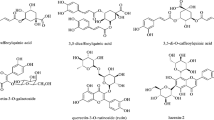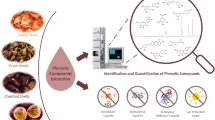Abstract
Antioxidant and in vitro anti-inflammatory activities of citrus (Citrus unshiu) peel extracts and their acid hydrolysates were evaluated. Citrus peel extracts were extracted by subcritical water, hot water, and ethanol. Subcritical water extraction led to extract more phenolic compounds than hot water or ethanol extraction. Acid hydrolysis more than doubled the extracts’ total phenolics and flavonoids. Acid hydrolysates showed greater DPPH-radical scavenging activities and antioxidant activities, as assayed by β-carotene bleaching and ferric thiocyanate, than the initial extracts. Anti-inflammatory activities of citrus peel extracts and hydrolysates, determined by the inhibition of hyaluronidase activity, showed that the inhibition activities of hot water and ethanol extracts increased from 2.1 and 1.8% to 37.0 and 18.5%, respectively, upon acid hydrolysis; however, the anti-inflammatory activity of the subcritical water extract was not improved. These results indicated that acid hydrolysis of citrus peel extracts regardless of their extraction methods improved the antioxidative and anti-inflammatory activities.
Similar content being viewed by others
References
Park H-J, Jung UJ, Cho S-J, Jung H-K, Shim S, Choi M-S. Citrus unshiu peel extract ameliorates hyperglycemia and hepatic steatosis by altering inflammation and hepatic glucose- and lipid-regulating enzymes in db/db mice. J. Nutr. Biochem. 24: 419–427 (2013)
Bovill HL. Orange: Source of natural compounds. Aromes Ingredients Additifs 7: 41–42 (1996)
Ma Y, Ye X, Hao Y, Xu G, Xu G, Liu D. Ultrasound-assisted extraction of hesperidin from Penggan (Citrus reticulate) peel. Ultrason. Sonochem. 15: 227–232 (2008)
Benavente-Garcia O, Castillo J, Marin FR, Ortuno A, Del Rio JA. Uses and properties of Citrus flavonoids. J. Agr. Food Chem. 45: 4505–4515 (1997)
Whiteman SC, Kurowska EM, Manthey JA, Daugherty A. Nobiletin, a citrus flavonoid isolated from citruss, selectively inhibits class a scavenger receptor mediated metabolism of acetylated LDL by mouse macrophase. Atherosclerosis 178: 25–32 (2005)
Yang YT, Kim MS, Hyun KH, Kim YC, Koh JS. Chemical constituents and flavonoids in citrus pressed cake. Korean J. Food Preserv. 15: 94–98 (2008)
Williamson G. Common features in the pathways of absorption and metabolism of flavonoids. pp. 21–33. In: Phytochemicals: Mechanisms of Action. Meskin MS, Bidlack WR, Davies AJ, Lewis DS, Randolph RK (eds). CRC Press, New York, NY, USA (2004)
Monforte MT, Trovato A, Kirjavaninenm S, Forestieri AM, Galati EML, Curto RB. Biological effects of hesperidin, a citrus flavonoid hypolipidemic activity on experimental hypercholesterolmia in rat. Il Farmaco 50: 595–599 (1995)
Haminiuk CWI, Maciel GM, Plata-Oviedo MSV, Peralta RM. Phenolic compounds in fruits-an overview. Int. J. Food Sci. Technol. 47: 2023–2044 (2012)
Cha JY, Cho YS. Biofunctional activities of citrus flavonoids. J. Korean Soc. Agric. Chem. Biotechnol. 44: 122–128 (1999)
Xu G, Ye X, Chen J, Liu D. Effect of heat treatment on the phenolic compounds and antioxidant capacity of citrus peel extract. J. Agr. Food Chem. 55: 330–335 (2007)
Ibanez E, Kubatova A, Senorans FJ, Cavero S, Reglero G, Hawthorne SB. Subcritical water extraction of antioxidant compounds from rosemary plants. J. Agr. Food Chem. 51: 375–382 (2003)
Waterhouse AL. Determination of total phenolics. pp. 463–470. In: Handbook of Food Analytical Chemistry: Pigments, Colorants, Flavors, Texture, and Bioactive Food Components. Wrolstad RE, Acree TE, Decker EA, Penner MH, Reid DS, Schwartz SJ, Shoemaker CF, Smith D, Sporns P (eds). John Wiley & Sons, Hoboken, NJ, USA (2005)
Quettier-Deleu C, Gressier B, Vasseur J, Dine T, Brunet C, Luyckx M, Cazin M, Cazin JC, Bailleul F, Trotin F. Phenolic compounds and antioxidant activities of buckwheat (Fagopyrum sculentum Moench) hulls and flour. J. Ethnopharmacol. 72: 35–42 (2000)
Bae HJ, Jayapraksha GK, Jifon J, Patil BS. Extraction efficiency and validation of an HPLC method for flavonoid analysis. Food Chem. 130: 751–758 (2012)
Savikin K, Zdunic G, Jankovic T, Stanojkovic T, Juranic Z, Menkovic N. In vitro cytotoxic and antioxidative activity of Cornus mas and Cotinus coggygria. Nat. Prod. Res. 23: 1731–1739 (2009)
Hidalgo ME, Fernandez E, Quihot W, Lissi E. Antioxidant activity of depsides and depsidones. Phytochemistry 37: 1585–1587 (1994)
Osawa T and Namiki M. A novel type of antioxidant isolated from leaf wax of eucalyptus leaves. J. Agr. Food Chem. 45: 735–739 (1981)
Lee J, Lee SH, Min KR, Lee KS, Ro JS, Ryu JC, Kim Y. Inhibitory effects of hydrolysable tannins on Ca+2-activated HAase. Planta Med. 59: 381–382 (1993)
Hassas-Roudsari M, Chang PR, Pegg RB, Tyler RT. Antioxidant capacity of bioactives extracted from canola meal by subcritical water, ethanolic, and hot water extraction. Food Chem. 114: 717–726 (2009)
Robbins RJ. Phenolic acids in foods: An overview of analytical methodology. J. Agr. Food Chem. 51: 2866–2887 (2003)
Moure A, Pazos M, Medina I, Dominguex H, Parajo JC. Antioxidant activity of extracts produced by solvent extraction of almond shells acid hydrolysates. Food Chem. 101: 193–201 (2007)
Sani IM, Iqbal S, Chan KW, Ismail M. Effect of acid and base catalyzed hydrolysis on the yield of phenolics and antioxidant activity of extracts from germinated brown rice. Molecules 17: 7584–7594 (2012)
Lee SC, Jeong SM, Kim SY, Nam KC, Ahn DU. Effect of farinfrared irradiation on the antioxidant activity of defatted sesame meal extracts. J. Agr. Food Chem. 53: 1495–1498 (2005)
Moon J-K, Shibamoto T. Antioxidant assays for plant and food components. J. Agr. Food Chem. 57: 1655–1666 (2009)
Forrester JV, Balaz EA. Inhibition of phagocytosis by high molecular hyaluronate. Immunology 40: 435–446 (1990)
Bleacher JC, Adolph VR, Dillon PW, Krummel TM. Fetal tissue repair and wound healing. Dermatol. Clin. 11: 677–683 (1993)
Jeong SJ, Kim NY, Ahn NH, Kim YC. Screening of hyaluronidase inhibitory activity using a microplate assay. Korean J. Pharmacogn. 29: 131–137 (1997)
Shibata T, Fujimoto K, Nagayama K, Yamaguchi K, Yamaguchi K, Nakamura T. Inhibitory activity of brown algal phlorotanins against hyaluronidase. International J. Food Sci. Technol. 37: 703–709 (2002)
Silva JC, Rodrigues S, Feas X, Estevinho LM. Antimicrobial activity, phenolic profile, and role in the inflammation of propolis. Food Chem. Toxicol. 50: 1790–1795 (2012)
Satardekar KV and Deodhar MA. Anti-aeging ability of Teminalia species with special reference to hyaluronidase, elastase inhibition, and collagen synthesis in vitro. Int. J. Pharmacogn. Phytochem. Res. 2: 30–34 (2010)
Author information
Authors and Affiliations
Corresponding author
Rights and permissions
About this article
Cite this article
Min, K.Y., Lee, K.A., Kim, H.J. et al. Antioxidative and anti-inflammatory activities of Citrus unshiu peel extracts using a combined process of subcritical water extraction and acid hydrolysis. Food Sci Biotechnol 23, 1441–1446 (2014). https://doi.org/10.1007/s10068-014-0197-y
Received:
Revised:
Accepted:
Published:
Issue Date:
DOI: https://doi.org/10.1007/s10068-014-0197-y




